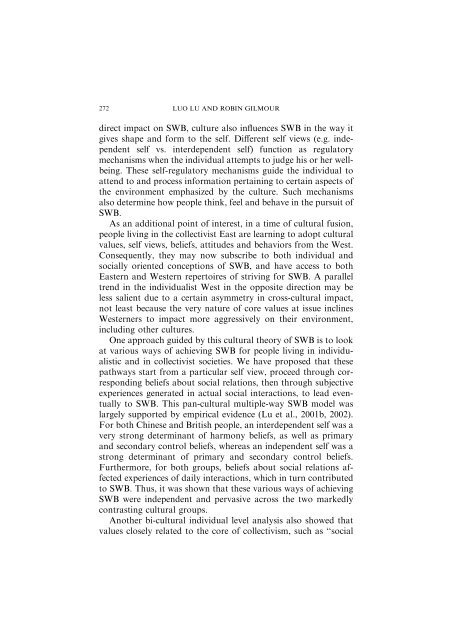CULTURE AND CONCEPTIONS OF HAPPINESS: INDIVIDUAL ...
CULTURE AND CONCEPTIONS OF HAPPINESS: INDIVIDUAL ...
CULTURE AND CONCEPTIONS OF HAPPINESS: INDIVIDUAL ...
You also want an ePaper? Increase the reach of your titles
YUMPU automatically turns print PDFs into web optimized ePapers that Google loves.
272LUO LU <strong>AND</strong> ROBIN GILMOURdirect impact on SWB, culture also influences SWB in the way itgives shape and form to the self. Different self views (e.g. independentself vs. interdependent self) function as regulatorymechanisms when the individual attempts to judge his or her wellbeing.These self-regulatory mechanisms guide the individual toattend to and process information pertaining to certain aspects ofthe environment emphasized by the culture. Such mechanismsalso determine how people think, feel and behave in the pursuit ofSWB.As an additional point of interest, in a time of cultural fusion,people living in the collectivist East are learning to adopt culturalvalues, self views, beliefs, attitudes and behaviors from the West.Consequently, they may now subscribe to both individual andsocially oriented conceptions of SWB, and have access to bothEastern and Western repertoires of striving for SWB. A paralleltrend in the individualist West in the opposite direction may beless salient due to a certain asymmetry in cross-cultural impact,not least because the very nature of core values at issue inclinesWesterners to impact more aggressively on their environment,including other cultures.One approach guided by this cultural theory of SWB is to lookat various ways of achieving SWB for people living in individualisticand in collectivist societies. We have proposed that thesepathways start from a particular self view, proceed through correspondingbeliefs about social relations, then through subjectiveexperiences generated in actual social interactions, to lead eventuallyto SWB. This pan-cultural multiple-way SWB model waslargely supported by empirical evidence (Lu et al., 2001b, 2002).For both Chinese and British people, an interdependent self was avery strong determinant of harmony beliefs, as well as primaryand secondary control beliefs, whereas an independent self was astrong determinant of primary and secondary control beliefs.Furthermore, for both groups, beliefs about social relations affectedexperiences of daily interactions, which in turn contributedto SWB. Thus, it was shown that these various ways of achievingSWB were independent and pervasive across the two markedlycontrasting cultural groups.Another bi-cultural individual level analysis also showed thatvalues closely related to the core of collectivism, such as ‘‘social

















